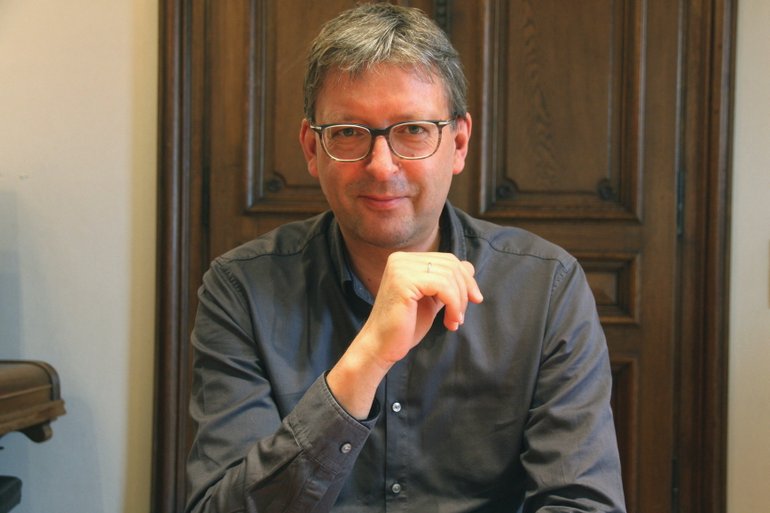Stuttgart ensemble offers memorable Bach for Easter at Broward Center

Hans-Christoph Rademann conducted Gaechinger Cantorey Wednesday night at the Broward Center. Photo: Hanns-Horst Bauer
Among sacred choral works, Johann Sebastian Bach’s Mass in B minor holds a special place. Composed at the end of Bach’s life, the score is a summation of his deep faith and mastery of choral and instrumental writing.
The Choir and Baroque Orchestra of the Internationale Bachakademie Stuttgart, has recorded Bach’s complete cantatas, passion settings and miscellaneous sacred works. Under former long-time director Helmuth Rilling, the group recorded the Mass in B minor no less than three times.
Newly rechristened Gaechinger Cantorey, the Stuttgart ensemble concluded the Broward Center’s classical season Wednesday night with an inspirational performance of Bach’s masterpiece. Hans-Christoph Rademann, Rilling’s successor, conducted the Fort Lauderdale concert.
Utilizing a 31-voice chorus and 29 instrumentalists, Rademann superbly brought out the contrasts of light and darkness that permeate the work while never allowing the music to turn ponderous. Poor intonation is often a common problem with period- instrument ensembles. That was definitely not the case with the Stuttgart players who took extra time tuning prior to both halves of the performance. The warm sound of the gut strings played with period bows enveloped the choral and solo vocal sections; winds made of wood rather than metal had unusual lightness and purity of sound.
The five vocal soloists were first rate. Roxana Constantinescu, a distinguished Baroque specialist, displayed a sizable warmly colored mezzo in the “Laudaumus De.” Her coloratura runs spanned a wide range without scooping or breaks in register. Soprano Regula Mühlemann’s high, soft and vibrato-less timbre contrasted with Constantinescu’s weightier voice in the duet “Et in unum Domine,” one of the evening’s vocal highlights. Tenor Jacob Pilgrim’s strong articulation and steely high range strongly partnered Mühlemann in a delightfully light “Domine Deus.”
In the Benedictus, tenor Benedikt Kristjánsson skillfully navigated the top range of the aria’s vocal line, singing almost like a countertentor in falsetto. The mellow, deep tones and rounded sonority of Peter Harvey infused the two bass arias with gravitas and unforced dramatic power.
The choir’s singing was wonderfully light and bright but it could turn on a dime to solemn moments that probe the depths of the human soul, passages given full weight by Rademann. In the “Kyrie eleison” the firmness of the male voices melded with the high tones of the sopranos. Balances were near ideal with the orchestra, with even the trumpets and timpani never overpowering the singers. There was vigor and incisive spirit in the “Gloria” with the instrumental writing underpinning the finely gauged dynamic gradations in the choral lines. In the “Credo,” which opened the post intermission portion of the performance, the walking rhythm in the cellos and bass was superbly blended with the choral overlay, followed by a vociferous outburst backed by clarion trumpet.
The entire group exhibited a degree of discipline unique among period ensembles. In the many arias with solo instrumental obbligato, Rademann had the featured player stand while playing, which not only gave the player greater prominence but helped bring out the solo instrumental line. One of Rademann’s most inspired touches was utilizing a lute rather than a harpsichord to join the organ, cellos, double bass and bassoons in the low continuo writing. Expertly played by Magnus Andersson, the instrument blended felicitously with plucked strings and winds. Special kudos to concertmaster Mayumi Hirasaki, flutists George Barthel and Dora Ombodi, , Oboists Katharina Arfken and Philipp Wagner, Hans-Martin Russ and Astrid Brachtendorf on trumpets, Ulrich Hübner playing valveless horn and organist Christine Kessler for outstanding solo work.
Rademann, a self effacing conductor who eschews podium histrionics, masterfully built the layers of Bach’s monumental score. From the springy string lines of the “Criste eleison” to the spacious pacing of “Aginus tibi” and the joyous “Osana,” Rademann maintained inexorable forward momentum over Bach’s long spans of melody. The performance appropriately reached its climax with Constantinescu’s patrician shaping of the “Agnus Dei” and Rademann’s deeply eloquent reading of the final “Dona Nobis Pacem,” the sublime culmination of this great performance of a singular masterpiece.
The two-page program, unfortunately, did not list the work’s individual movements nor were printed or projected texts provided. Partly as a result, some audience members initially applauded after each movement but eventually realized this was a multi-section, large-scale work. The audience listened with unusual attentiveness. Throughout the mass’s nearly two hour time span, hardly a cough, fidget or dropped program was heard. All credit to Broward Center classical series curator James Judd for booking this superb ensemble, a wonderful holiday gift for Easter and Passover week.
Posted in Uncategorized
Leave a Comment
Thu Apr 13, 2017
at 12:58 pm
No Comments






